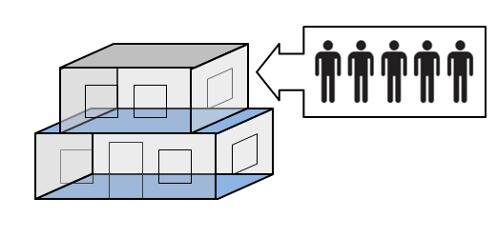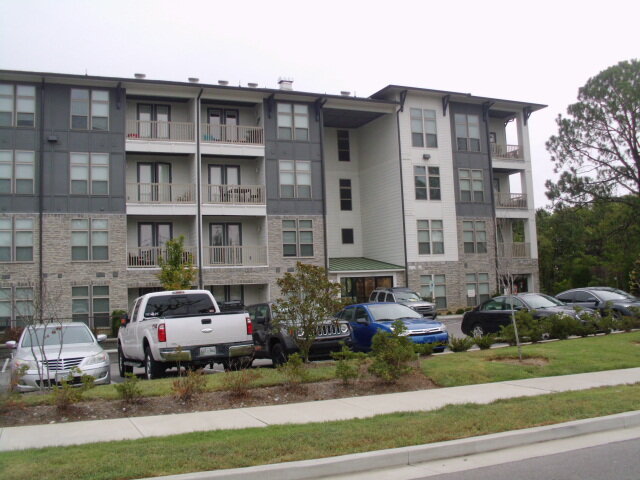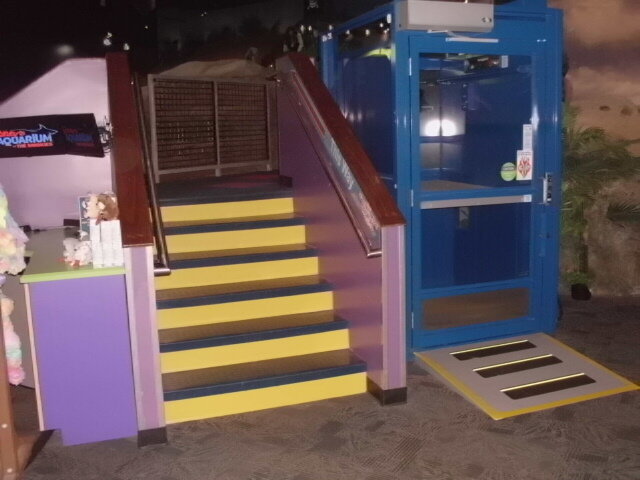Accessible Routes in Multi-Story Buildings and Facilities - Basic
Elevators
Multi-story buildings and facilities can require an accessible route, as defined by the Americans with Disabilities Act (ADA), to move above and/or below the main level of entry. Usually this is accomplished by elevators or ramps. This article will focus on elevators. The photo on the right is representative of a group of three elevators.
According to ADA Standards at least one accessible route should connect each story and mezzanine in multi-story buildings and facilities. However, there are exceptions to this ADA Standard. But first we will define an accessible route.
Accessible routes consist of one or more of the following components: walking surfaces with a running slope not steeper than 1:20, doorways, ramps, curb ramps excluding the flared sides, elevators, and platform lifts. So elevators can be part of an accessible route.
Exception 1. In private buildings or facilities that are less than three stories or that have less than 3000 square feet per story, an accessible route is not be required to connect stories provided that the building or facility is not a shopping center, a shopping mall, the professional office of a health care provider, a terminal, depot or other station used for specified public transportation, an airport passenger terminal. The ADA Standards for an elevator exemption say that for the purposes of the ADA, a shopping center or shopping mall means a building housing five or more sales or rental establishments, [among others]. The graphic below is representative of less than 3 stories.
The graphic below is representative of a building with less than 3000 square feet per story.
Each Floor is Less Than 3000 SF
The graphic below is representative of a two story building with a health care provider office on the second floor (left) and another building with 5 sales/rental establishments total on the first and second floors (right). So in each case an accessible route (elevator, shown in yellow) is required for these buildings.
Medical Office Five Sales/Rental Establishments
The exemptions for elevators does not eliminate or limit in any way the obligation to comply with the other ADA accessibility requirements established in the ADA Standards. Spaces and elements located on a level not required to be served by an accessible route must fully comply with the ADA Standards. For example, alterations to floors above or below the accessible ground floor must be accessible regardless of whether the altered facility has an elevator. In other words, all other provisions for ADA compliance (like accessible toilet rooms) still apply to stories & mezzanines not served by an accessible route because an elevator or ramp may go in later or, ambulatory disabled individuals may go to those other levels by other means.
While a mezzanine may be a change in level, it is not a story. If an accessible route is required to connect stories within a building or facility, the accessible route must serve all mezzanines as well. The photo below is representative of a mezzanine.
Mezzanine
Exception 2. Where a two story public [government] building or facility has one story with an occupant load of five or fewer persons [and] that one story does not contain public use space, that story is not required to be connected to the story above or below. The graphic below is representative of this exception where the second floor has a maximum occupancy of 5 and no public use space, hence no elevator or ramp required.
Elevator Exemption 2 - Two Story Building with No Elevator
Exception 3. In detention and correctional facilities, an accessible route shall not be required to connect stories where cells with mobility features required to comply with the ADA Standards, all common use areas serving cells with mobility features required to comply with the ADA Standards, and all public use areas are on an accessible route. In other words an elevator is not required to connect the different stories if a different accessible route, such as ramps, is made available.
Apartment Building
Exception 4. In residential facilities like an apartment building, an accessible route [elevator] is not required to connect stories where residential dwelling units with mobility features, all common use areas serving residential dwelling units with mobility features, and public use areas serving residential dwelling units are on an accessible route. In other words, in apartment buildings, an elevator is not required as part of a route by the ADA, as long as there is a route by other means, such as ramps. Note however, that an elevator may be required by the FHA connecting to floors with “covered” units. The photo above is representative of an apartment building.
Common Use Area is defined as “interior or exterior circulation paths, rooms, spaces, or elements that are not for public use and are made available for the shared use of two or more people.” So common use areas are made for the people who live there. Public Use Area is defined as “interior or exterior rooms, spaces, or elements that are made available to the public. Public use may be provided at a building or facility that is privately or publicly owned.” So public use areas are made for all people, whether they live there or not.
Where common use areas are provided for the use of residents, it is presumed that all such common use areas serve accessible dwelling units unless use is restricted to residents occupying certain dwelling units. For example, if all residents are permitted to use all laundry rooms, then all laundry rooms serve accessible dwelling units. However, if the laundry room on the first floor is restricted to use by residents on the first floor, and the second floor laundry room is for use by occupants of the second floor, then first floor accessible units are served only by laundry rooms on the first floor. In this example, an accessible route is not required to the second floor provided that all accessible units and all common use areas serving them are on the first floor.
Exception 5. Within multi-story transient lodging guest [hotel] rooms with mobility features required to comply with the ADA Standards, an accessible route [elevator] is not required to connect stories provided that spaces complying with the ADA Standard are on an accessible route and sleeping accommodations for two persons minimum are provided on a story served by an accessible route. So an elevator is not required as part of an accessible route for a multi-story hotel as long as accessible rooms are on an accessible route by other means (such as ramps) and there are sleeping rooms for at least 2 people on the story.
Air Traffic Control Towers
Exception 6. In air traffic control towers, an accessible route shall not be required to serve the cab and the floor immediately below the cab. The cab is the area where the employees work and the large windows are present for observing the airport. The floor immediately below the cab is another area where employees work and much of the support machinery is located. The photo on the right is representative of an airport traffic control tower.
Historic Building
Exception 7. Where exceptions for alterations to qualified historic buildings or facilities are permitted by the ADA Standards, an accessible route shall not be required to stories located above or below the accessible story. The ADA Standards say you don’t have to install an elevator if the elevator installation will threaten or destroy the historic significance of the facility. The photo on the left is an example of a historic building.
Lift Installed at Stairs











